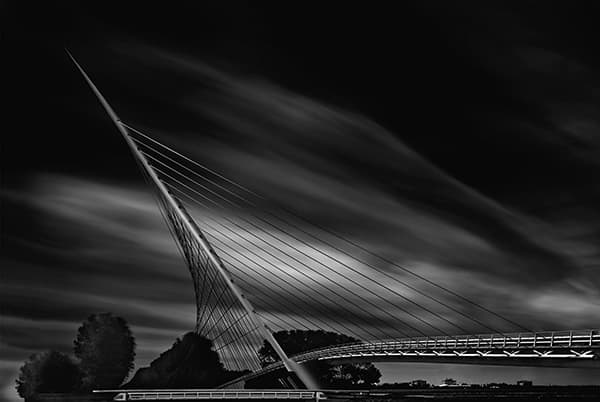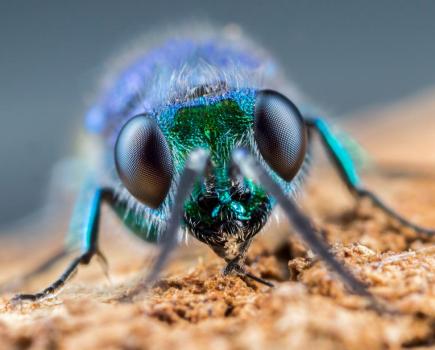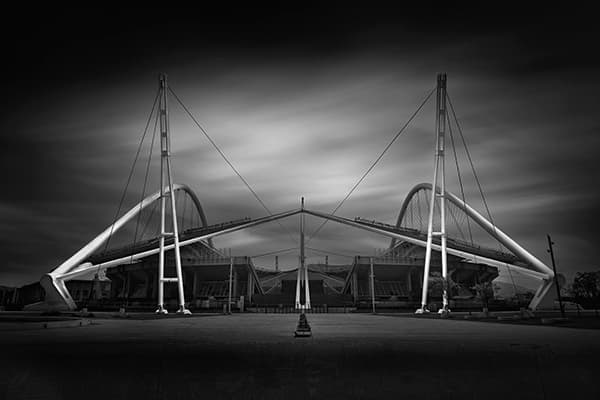
Grasshopper
Canon EOS 6D,
17-40mm, 429secs at f/10, ISO 100
The city, like any landscape, can be a photographic safari. The sweeping skylines and intricate details of the streets can be utilised to create images that are at once familiar yet at times strangely alien. If you look through any portfolio of street photography you’ll notice that while you recognise the things you’re seeing, the photographer has somehow succeeded in drawing out something a little different.
It’s the same with architecture photography. So many of us make the commute to work with our eyes down and our ears plugged with music. How often do you stop, pause the tunes, and let your eyes soak in the monolithic works of art that almost seem to touch the sky. And how often do you photograph them?
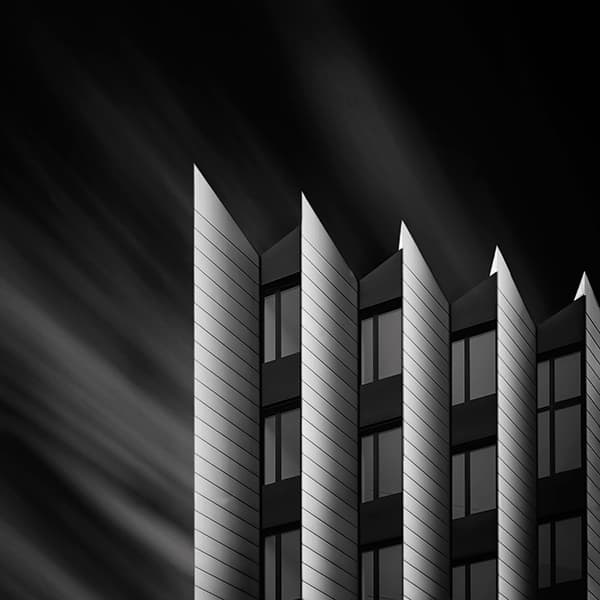
The Office
Canon EOS 6D,
24mm, 211secs at f/11, ISO 200
Taking record photographs of buildings is simple, but creating artistic interpretations of architecture is quite a different matter. If you’re looking for inspiration, then the work of Belgium-born Noel Baldewijns is a great place to start.
Noel’s beginnings are not what you’d expect. For years, he worked in the chest-beating, high-pressure madness of the European finance industry. He’s retired now, but that doesn’t mean he’s slowed down. In fact, Noel decided to swap crunching numbers for calculating exposures. He had long been interested in photography – Alfred Stieglitz is a particular favourite – and decided to use his retirement to get his creative juices flowing. Thus he decided to pick up a camera and take to the streets to see if he could create a body of work that would bring out the character of the buildings he had so often in his career found himself occupying or simply gazing at.
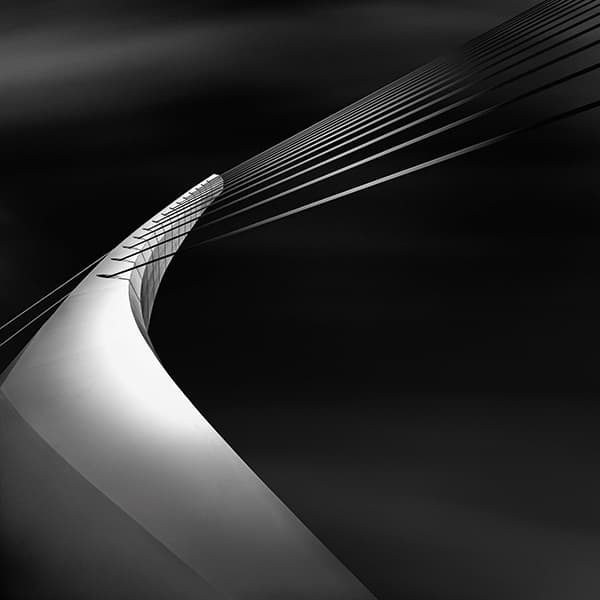
Strings I
Canon EOS 6D,
17-40mm, 464secs at f/13, ISO 100
Noel’s primary subject matter is the ultra-modern constructions of Norman Foster, Frank Gehry and Santiago Calatrava. These architects are at the forefront of the modernist form of buildings. You’ll know the kind of style being spoken about – uncluttered, clear structures, focused on lucid forms, very geometric and very minimalist.
In the UK, Foster is perhaps best known of the three – think of the highly sculptural shapes of buildings like the Gherkin in London. Gehry is known for his deconstruction and reformulation of building shapes that are sleek and playful, such as the Museum of Modern Art in New York and the Walt Disney Concert Hall in Los Angeles in the USA. Calatrava creates buildings that reflect natural shapes and rhythms. He takes inspiration from things such as birds with outstretched wings (Lyon railway station in France) and a turning torso (Turning Torso Tower, Malmö, Sweden).
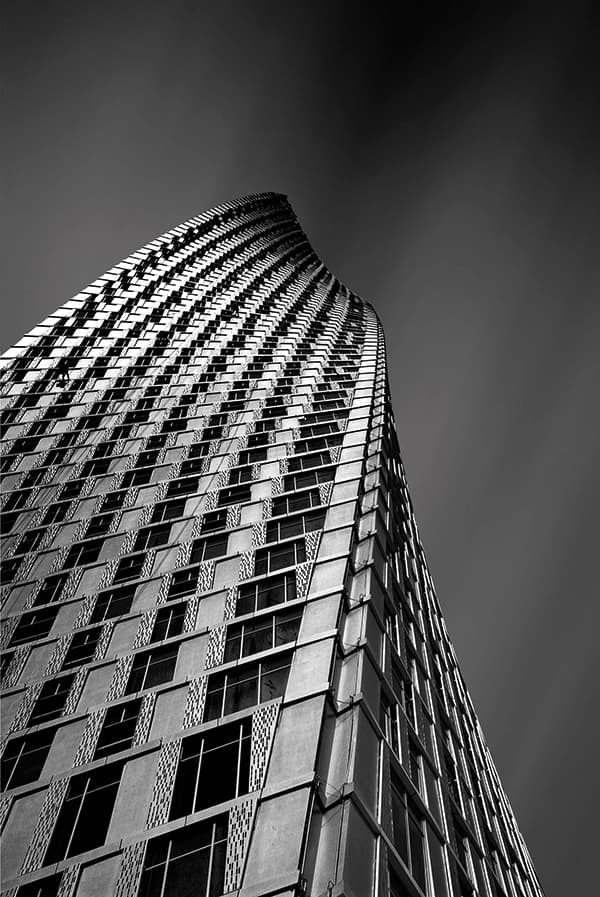
Triptych I
Canon EOS 6D,
24mm, 1/640sec at f/13, ISO 100
Noel’s images attempt to echo the modern feel of these buildings. The look is strongly stylised, with a black sky, streaky clouds, segments of buildings and dramatic lines, and the pictures are always sleek and dramatic. The photographs are an attempt to reflect the borderline adrenaline rush that he feels when viewing these incredible buildings.
‘Calatrava’s designs are based on birds and human bodies in motion, such as dancers, sportsmen and so on,’ says Noel. ‘This leads almost always to overwhelming structures. It’s almost as if the buildings have the intention of flying away. From other buildings you can see the inspiration of insects and even musical instruments.
‘With Foster’s designs, I’m attracted by how functional they are. When you walk in the City in London, there’s a whole area developed by him where there is a play of light surrounding these buildings. Gehry and his swinging constructions are well known. I’d like to create a photographic series with different parts of his design. With all these photographers the buildings and structures are quite difficult to shoot, but the results can be massively rewarding.’
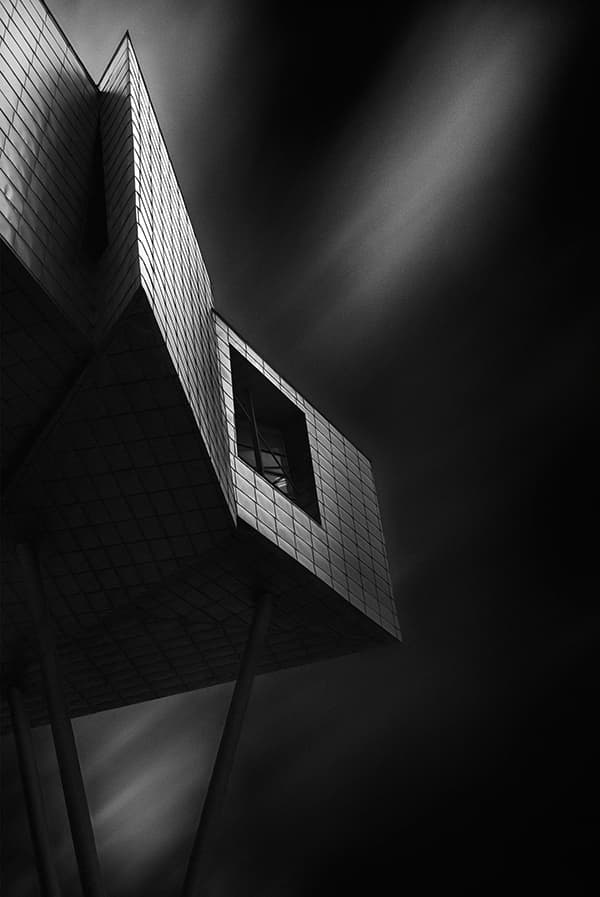
Tripod
Canon EOS 6D,
17-40mm, 202secs at f/9, ISO 200
Capturing the scene
Noel’s images go way beyond simply being photographs of buildings – it’s a style that takes modernist architecture as its catalyst. The difference between photographing buildings and photographing architecture is rooted in what Noel refers to as the emotional content in the images.
‘Before I even pick up my camera, I try to connect with the master architect by actually researching them,’ he says. ‘I find out what their background is, how they think, and what they were trying to convey when they worked on the plans for the building. I combine this research with my own focus, such as what do I want to convey with my work? What things do I want the viewer to experience when seeing my images? What story do I want to tell?’
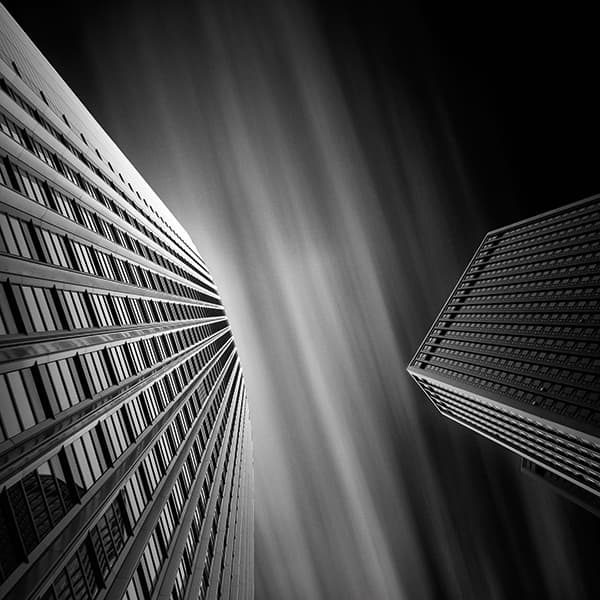
Duo
Canon EOS 6D,
18-200mm, 331secs at f/7.1, ISO 100
Noel then spends time carefully planning everything before making the images. ‘It’s not like I wake up in the morning and decide to go out and shoot,’ says Noel. ‘For me, this doesn’t work. I prepare a long time in advance, find out what surrounds the construction, how I [can] get access and permission to photograph, what hour the sun rises and how the sun will turn around the construction. Nearer the time of the actual shoot I’ll check the weather forecasts because I want to know if and when there will be clouds and what type of clouds. If the weather is not what I need, then I’ll cancel the trip. So you see, preparation is time consuming, and often travelling is involved soI really need to prepare. No preparation means no successful shooting.’
The impact of the images is a combination of photographic technique, composition, use of an ND filter to ensure he can achieve the necessary slow exposures and capture the streaking clouds, and then black & white post-processing. Noel describes how he likes to keep his pictures ‘tight’, with no distractions, and how everything is pared down with a minimalist aesthetic. He is not afraid to use negative space as this balances the building and allows for a chiaroscuro interplay between sky and building.
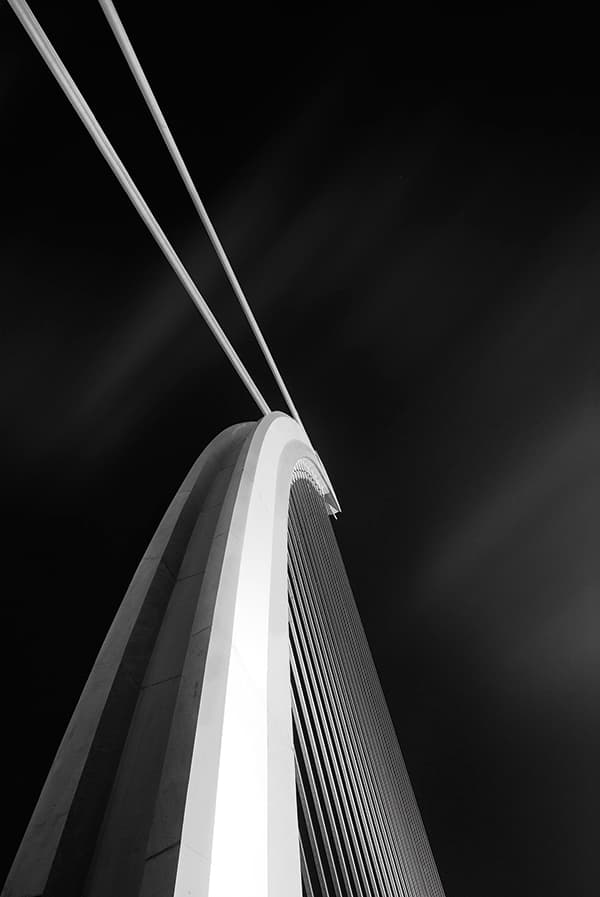
Strings II
Canon EOS 6D,
10-20mm, 1/1,250sec at f/5, ISO 100
Noel explains the process of making an image. ‘I start measuring the light in manual mode,’ he explains. ‘I determine the white point in the expected frame, then I make some test shots. For me, the most interesting settings, if possible, are 1/200sec at f/8 at the lowest possible ISO, which is usually ISO 100. Depending on the available clouds and what I want to achieve, I will then slow down the exposure by 13-16 stops. I use a transformation table, so 1/200sec with 16 stops becomes an exposure time of about 5 minutes. When I use more than 10 stops, I add 40-50% extra exposure time. So in the example above, the 5 minutes becomes 7 minutes.
‘Most of the time I need to do more than one shot to get the result I want, so taking the photo I am looking for sometimes lasts around an hour. I cover my camera with a big dark mantle or cover to avoid light leakage. Mieke [my wife] made the mantle for me. It starts at the front of my lens, goes over my camera and covers the ballhead and a part of the tripod.
I sometimes get strange reactions from people and once I was questioned by the police!’
Finally, Noel converts his image to black & white. ‘I’ve previsualised the image from the start in monochrome,’ he says. ‘It affects how I see the shoot. I’m already seeing the drama in the final image, and I then bring that out using luminosity masking in the post-processing. This gives the images a sense of timelessness.’
Indeed, the light does seem to shine from the images because they positively glow. I ask Noel about his approach to abstracts – is there a different way of ‘seeing’ an abstract versus ‘seeing’ the whole?
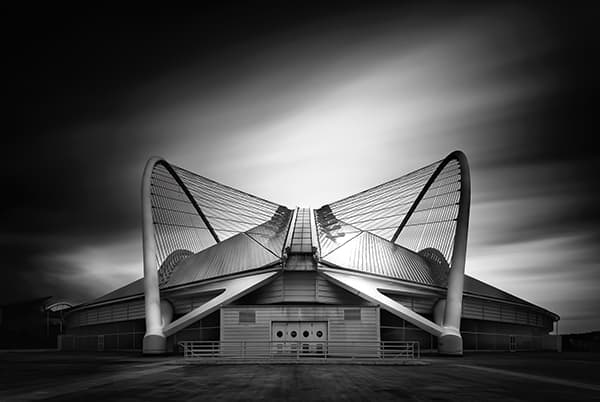
Bug
Canon EOS 6D,
24mm, 426secs at f/11, ISO 100
‘It depends on how I feel that day,’ he says. ‘Some buildings are very impressive and need to be photographed as a whole. When you look at my sporting stadium shots I photograph them as a whole because of the exciting design. For me, they sort of look like a bug, so I don’t see any reason to mask that by going abstract. I just see the bug shape. But at the same time I keep my own dramatic style. On the day that I shot the stadium there were thunderstorms in the air, which created a great atmosphere and gave a nice backdrop of moody clouds right behind the stadium. In my preparation I never thought to shoot abstract there. Other buildings, you can’t help but shoot them as abstracts.
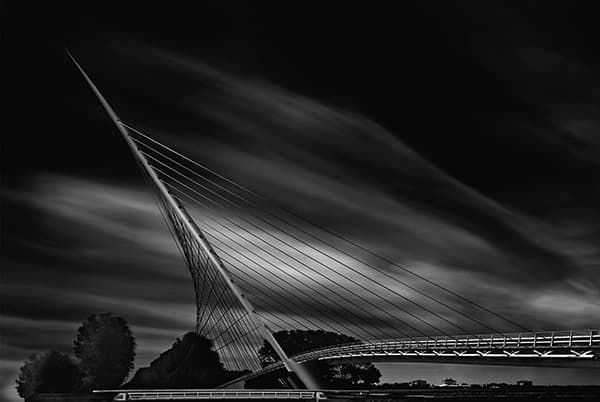
Calatrava Bridge
Canon EOS 6D,
17-40mm, 465secs at f/14, ISO 100
For example, when I walked around the City of Arts and Sciences in Valencia, Spain, I felt Calatrava must have been very proud creating this. So I started to look around for a place that could honour that feeling. There was a pedestrian bridge that offered the ideal perspective. After a few hours I came up with the idea of looking at that bridge upside down (I did this on my iPad, which is connected to my camera), and I had the shot. I could previsualise a peacock, the symbol of pride. I would never photograph that bridge as a whole.’
Noel’s images capture the sleek, radical and yet organic, sensual forms of the buildings he photographs. It’s a style of imagery that feels very uncluttered and modernistic in its approach – very much a 21st-century eye.
About Noel Baldewijns
Having spent his working career in the European financial industry, Noel retired in 2011, took a degree at the Academy of Fine Arts in Heusden, Belgium, and has since dedicated himself to black & white imagery of modern architecture. To see more of his work visit www.nba-photography.org

